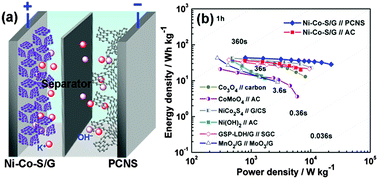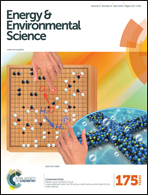Electroactive edge site-enriched nickel–cobalt sulfide into graphene frameworks for high-performance asymmetric supercapacitors†
Abstract
Tailor-made edge site-enriched inorganics coupled graphene hybrids hold a promising platform material for high-performance supercapacitors. Herein, we report a simple strategy for fabricating edge site-enriched nickel–cobalt sulfide (Ni–Co–S) nanoparticles decorated on graphene frameworks to form integrated hybrid architectures (Ni–Co–S/G) via an in situ chemically converted method. The Kirkendall effect-involved anion exchange reaction, e.g. the etching-like effort of the S2− ions, plays a crucial role for the formation of the edge site-enriched nanostructure. Density functional theory (DFT) calculations reveal that the Ni–Co–S edge sites have a high electrochemical activity and strong affinity for OH− in the electrolyte, which are responsible for the enhanced electrochemical performance. Benefiting from the integrated structures of Ni–Co–S nanoparticles and conductive graphene substrates, the resultant Ni–Co–S/G hybrid electrodes exhibit a high specific capacitance of 1492 F g−1 at the current density of 1 A g−1, a superior rate capability of 96% when the current density is increased to 50 A g−1, and excellent electrochemical stabilities. An asymmetric supercapacitor fabricated using the edge site-enriched Ni–Co–S/G hybrids as the positive electrode and porous carbon nanosheets (PCNS) as negative electrodes shows a high energy density of 43.3 W h kg−1 at a power density of 0.8 kW kg−1, and an energy density of 28.4 W h kg−1 can be retained even at a high power density of 22.1 kW kg−1.



 Please wait while we load your content...
Please wait while we load your content...